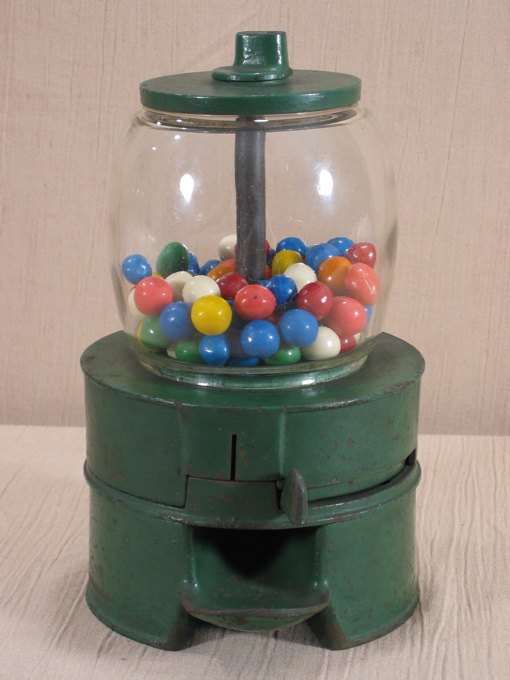___________________________________________________________________________________________
Mystery 19

___________________________________________________________________________________________

Maker unknown, c. 1910's or 1920's, 9 3/4". I'm estimating the date on this machine, but I'd be surprised if it dated to later than the 1920's. It's made of cast iron and is a small machine but very dense; it's got a great heft factor. Bill Enes said that collectors call this a "lantern vendor" because of the lantern globe, but he doesn't mention why the dozen other models with lantern globes also aren't called lantern vendors. I guess since they had other names, the other names prevailed, but this orphan needed some identity so "lantern vendor" is it.
The facts that it's made of cast iron, is 9 3/4"tall, and has a lantern globe is about all that's known of this machine. Its history is a complete mystery. It's not a rare machine, although they're not common.
The story of how I acquired this is educational, so I'll pass it along even though it makes me look foolish. This machine appeared at an auction in Cincinnati, which is only a couple of hours from my house. It was the only thing in the auction that excited me, but it excited me enough that I decided to drive to the auction and buy it. Note that I didn't say I'd drive to the auction and bid on it, or try to buy it, or go strong on it; I went to buy it and told my wife and a friend of mine that I wasn't coming home without it.
I advise you to never do that. You never know who else has the same strength of desire, and it can cost you. In the past I'd always determined my maximum bid on an item before the item appeared on the block, and was disciplined enough to not exceed my maximum. This is the only significant piece that I can remember not setting my max, and therefore I had only a soft ceiling set by my pre-auction expectations, not a hard ceiling set by the disciplined approach I usually take.
The bids crept slowly upward, back and forth between me and a phone bidder. The bid went past the "bargain range," then exceeded the range in which it should have sold, then exceeded the "strong money" range and nudged into Stupid Money territory. I bowed out at the next bid to me, and as the auctioneer looked around the room to see if anyone else wanted in, I thought "Damn it, I said I wasn't coming home without this," and got back in. Two bids later the machine was mine, at Stupid Money Plus.
This is an example of how not to manage an auction. On the negative side I felt like a sucker for awhile, with good reason. I paid twice (or more) what the machine was worth to any rational collector and would never have bid that much had I followed the Golden Rule I'd always followed before: Know when to stop. On the plus side, this is a model that I'd loved and wanted for a long time, and I'd never had the chance to own a nice original example. It's an awesome machine, I love it, and I doubt that a nicer example exists. Friends who are familiar with the machine and the story agree that it's the nicest example they've ever seen---as they snicker at me.
The example pictured above is 100% original.
___________________________________________________________________________________________
___________________________________________________________________________________________
©Small Vintage Vending 2009